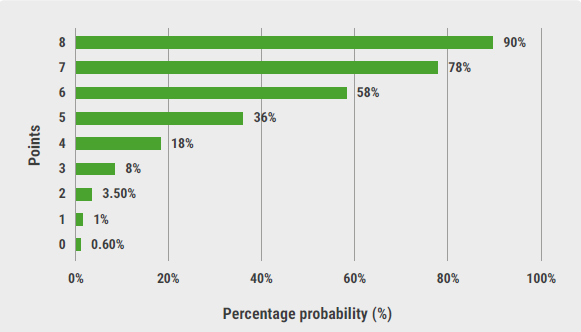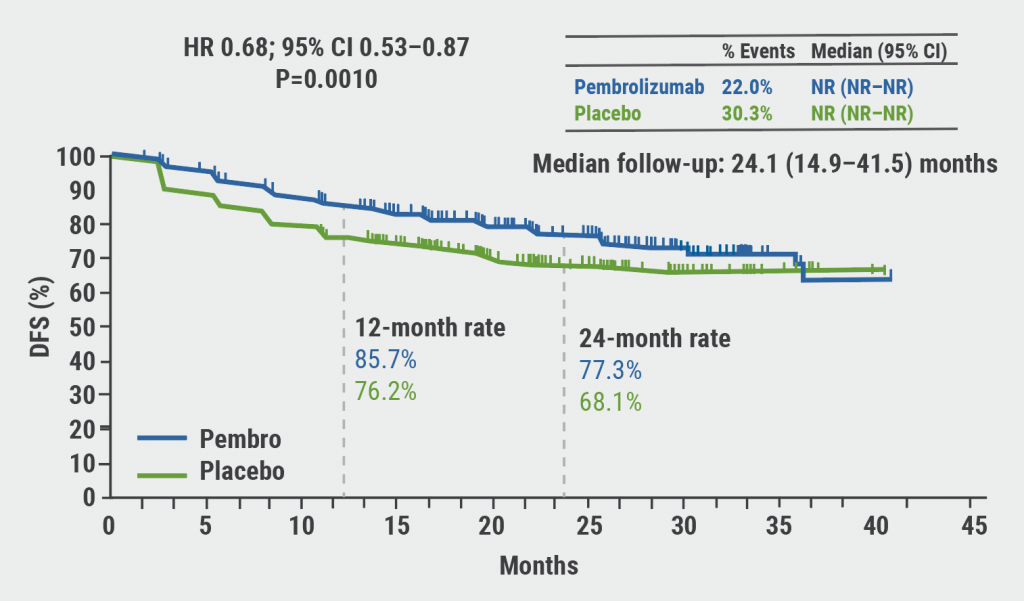The presence of brain metastasis is a negative prognostic factor in patients who have a GCT; Dr Ryan Ashkar (Indiana University Simon Comprehensive Cancer Centre, Indiana, USA) and his team sought to identify factors to establish a model to predict patients at risk for developing brain metastasis [1]. To this end, 2,291 patients from a prospectively maintained database were identified who had been treated for testicular cancer at Indiana University between January 1990 and September 2017.
Patients were separated into 2 groups based on the presence (n=154; 6.7%) or absence (n=2,137; 93.3%) of brain metastasis. Kaplan-Meier analysis demonstrated a 2-year progression-free survival of 17% versus 65% (P<0.001) in those with brain metastasis versus those without. The same method showed an overall survival rate of 62% in patients with brain metastasis compared with 91% (P<0.001) in those without.
The data was then divided into datasets for training and validation of the model with equal numbers of events in each dataset. Logistic regression was used to identify a predictive model for the presence of brain metastasis. The resulting model identified weighted variables that can be used to predict progression to brain metastasis:
- age of ≥40 at time of diagnosis (1 point);
- b-hCG level ≥5,000 prior to chemotherapy (1 point);
- the presence of bone or pulmonary metastases, with pulmonary metastases further subdivided into those <3 cm or ≥3 cm:
- bone metastasis (1 point);
- pulmonary metastasis <3 cm (2 points);
- pulmonary metastasis ≥3 cm (3 points); and
- histology demonstrating a predominance of choriocarcinomatous cells (2 points).
The total number of points yields a corresponding probability of progression to brain metastasis (see Figure).
Figure: Probability of brain metastasis, as characterised by the prediction model [1]

Dr Ashkar concluded that this model can predict the occurrence of brain metastasis in patients with metastatic GCTs and recommend its use by clinicians to identify patients at risk of developing brain metastasis.
- Ashkar R. Prediction model for brain metastasis (BM) in patients with metastatic germ-cell tumours (mGCT) accounting for size of pulmonary metastases. Abstract 378, ASCO Genitourinary Cancers Symposium, 11–13 February 2021.
Copyright ©2021 Medicom Medical Publishers
Posted on
Previous Article
« Reduction in radiation exposure is possible in testicular seminoma surveillance Next Article
Better prediction of favourable responses to immune checkpoint inhibitors in mUC »
« Reduction in radiation exposure is possible in testicular seminoma surveillance Next Article
Better prediction of favourable responses to immune checkpoint inhibitors in mUC »
Table of Contents: ASCO GU 2021
Featured articles
Prostate Cancer
Lu177 as a promising new therapy for metastatic prostate cancer
Role of prostate cancer genomics is evolving
Apalutamide prolongs progression-free survival in prostate cancer
Dose-intensified radiation therapy fails to provide better outcomes in prostate cancer
Intrinsic tumour biology may be predictive of treatment response in prostate cancer
Final TITAN trial results favour use of apalutamide
Penile Cancer
Prognosis of penile cancer associated with HPV status
Renal Cancer
Superior clinical outcomes and QoL with nivolumab plus cabozantinib in RCC
Lenvatinib plus pembrolizumab prolongs survival in renal cell carcinoma
Inflammatory markers may guide treatment decisions in metastatic renal cell cancer
Clinical trial exclusion criteria may lead to lack of evidence in real-world patients: how do the excluded fare?
Axitinib offers hope for improving renal cell cancer surgical outcomes
Cabozantinib as possible new first-line therapy in translocation renal cell carcinoma
Predictors of oral anti-cancer agent utilisation in renal cell carcinoma
Denosumab plus pembrolizumab in advanced clear cell renal cell carcinoma
Testicular Cancer
New prediction model for brain metastasis in germ cell tumours
Reduction in radiation exposure is possible in testicular seminoma surveillance
New therapeutic option for early metastatic seminoma
Urothelial Cancer
Poorer outcomes in bladder cancer predicted by race/ethnicity and gender
Enfortumab vedotin as a promising treatment option for bladder cancer: phase 3 results
Enfortumab vedotin as a promising treatment option for bladder cancer: phase 2 results
New standard of care recommended for patients with upper tract urothelial cancer
Signature DNA alterations in subtypes of bladder cancer
ACE inhibitors associated with superior responses in bladder cancer
Better allocation of research dollars needed
Better prediction of favourable responses to immune checkpoint inhibitors in mUC
Genitourinary Oncology
Researchers call for an overhaul of licensing and funding of anti-cancer drugs
Exploring a new strategy for metastatic germ cell tumours
© 2024 Medicom Medical Publishers. All rights reserved. Terms and Conditions | Privacy Policy


